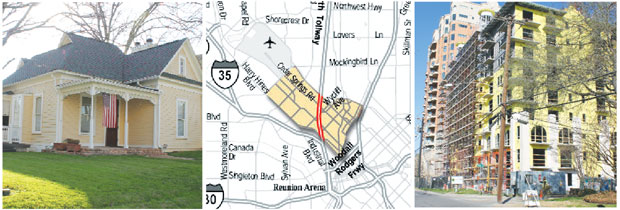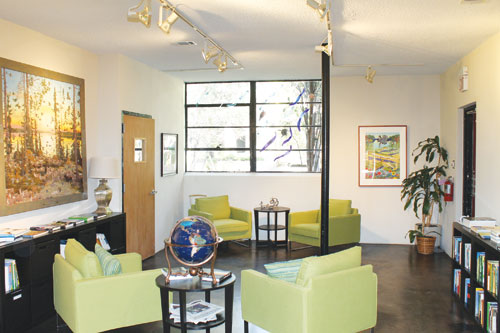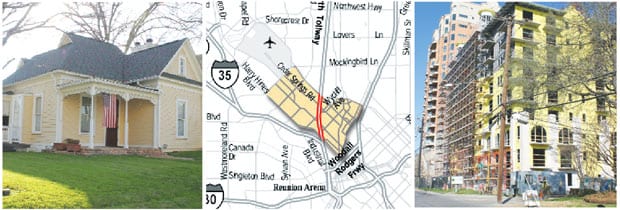Oak Lawn’s charming single-family homes and duplexes are being razed to build high-rise condos priced up to $1.5 million

MOVIN’ ON UP | An early 20th century Oak Lawn home, left, is one block away from the pricey residential towers, right. Hundreds of similar homes have been razed during the past decades to make room for the high-rises. Oak Lawn includes Uptown and Victory and stretches from Central Expressway to Love Field. 75219 is entirely within Oak Lawn and is the second most densely populated zip code in the city.
When John Moser moved out of Oak Lawn 20 years ago, he was certain he would miss the sense of community that defined the area. His downtown-based company covered his costs for using public transportation, and on weekends he could walk to clubs and restaurants.
“I loved living in Oak Lawn when I first moved to Dallas,” Moser said. “Buying a house in North Dallas was a difficult decision, but you know what? They couldn’t pay me to live in Oak Lawn today. And where would I live? The house I lived in was torn down.”
It wasn’t the only one. During the past several decades, developers have razed hundreds of the single-family homes built in the early 20th century to make room for structures that could house more people on the same amount of land.

REPURPOSED | Instead of razing an older buildling, Herschel Weisfeld renovated a dilapidated building in Oak Lawn, which now houses executive offices and a private art gallery. Weisfeld prefers to employ “adaptive reuses” for buildings that others would bulldoze. (Steve Ramos/Dallas Voice)
“Single-family homes gave way to duplexes. Duplexes were torn down to make room for fourplexes, and then those were torn down, so developers could build multi-storied condos and apartment buildings,” Herschel Weisfeld said. Weisfeld owns the former Dallas County Mental Health/Mental Retardation Building on Routh Street. He converted it into the SOTA (State of the Art) building which houses executive office suites and a private art gallery.
The SOTA building is surrounded by examples of what Oak Lawn was and what it has become. Just a few feet down Hood Street, a well-kept bungalow snuggles next to an immaculate early 20th century home with a gingerbread-decorated porch. In the mid 20th century, Oak Lawn was dotted with hundreds of those homes, many of them built in the Craftsman and other styles.
“There isn’t much left of all that now,” Weisfeld said.
Where did it go? Dallas Landmark Commissioner Michael Amonett provides part of the answer. He said the mix of single-family and multifamily housing on the same blocks in Oak Lawn meant preservation-minded neighbors were unable to organize neighborhoods into historic or conservation districts. That mix began in the 1950s as Dallas began to expand into a large, modern city.
But now, those small apartment complexes are being replaced with taller, denser buildings, and Amonett believes unscrupulous developers are responsible for the transformation of Oak Lawn into a crowded, traffic-plagued neighborhood.
“They looked at the single-family homes and said, ‘I could stack two or three $500,000 condominiums on top of that one house,’” Amonett said.
Oak Lawn has only two neighborhood associations, Perry Heights and Maple Springs, compared to the more than 30 in Oak Cliff. Amonett said that before a developer builds in Oak Cliff, the neighborhood asks for a traffic study, but no one in Oak Lawn asks for them.
It shows. The Texas Department of Transportation reports that Lemmon Avenue, from Inwood Road to Haskell Avenue, is the most congested city street in the state that is not a highway. It causes 146,997 hours of delay per mile each year.
It’s the same in other cities, according to Amonett. Neighborhoods are being cleared of their architecturally interesting homes to make way for condos and apartments, which brings in more people whose cars clog the streets not designed for those numbers.
“The machine wants more taxable square footage,” Amonett said. “Go to any city, andthey’re all talking about density.”
That drive is eliminating single-family and small apartment complexes. In their place, developers are building what Amonett calls “Eastern Bloc communist country housing.”
“There’s no advocate for historic preservation in Oak Lawn,” said Mark Doty, who works in the Dallas Historic Preservation office in City Hall.
Buildings that don’t have a Dallas historic designation will be torn down because of simple economics: The land is worth more than the buildings that sit on the property.
“We’re losing the charm and allure of Oak Lawn to new construction,” Doty said.
In the 1960s, Oak Lawn became a magnet for the counterculture movement with its inexpensive rents and closeness to Lee Park. By 1980, it had become Dallas’ gayborhood. Doty isn’t opposed to the development of the area, but there are Oak Lawn properties he’d like to see preserved.
“I’d like to see Sam Houston School designated,” he said.
The school, established in 1909, is located behind the clubs on Throckmorton Street. Doty also would like to see some of the fourplexes between Lemmon
Avenue and Highland Park given landmark status. Oak Lawn’s future, though, may not be as dire as Doty predicts.
None of Weisfeld’s properties has landmark status, but he’s worked to preserve and renovate his buildings.
“The challenge is taxes,” Weisfeld said. “Taxes don’t incentivize a person to preserve a property.”
When Weisfeld bought the building on Routh Street, it suffered from extensive water damage and some of the ceilings were caved in. Instead of razing the building, however, he repaired it and capitalized on the solid wood doors and concrete walls and ceilings.
“I’ve done adaptive reuses,” he said.
The Weisfeld Center in Downtown Dallas is another of his renovations, and he’s received a number of awards for his efforts. The Urban Forestry Council honored him for saving a hickory tree on his property that is the largest of its species in Oak Lawn. Former Dallas Mayor Ron Kirk presented Weisfeld with a proclamation, and Preservation Dallas honored him with two awards to acknowledge his work on the SOTA building and the Weisfeld Center.
“Historic preservation is important,” Weisfeld said. “Coexisting with development adds character to a neighborhood and adds uniqueness.”
New and old buildings can live together, Weisfeld added, noting the Old Parkland campus as an example. The original building was renovated and preserved, while the design of additional high-rise office towers on the campus mimic the original style.
However, Weisfeld doesn’t believe Oak Lawn neighborhood’s narrow streets can live with the additional cars a new 10-story building a block away will add to the congestion. That residential tower sits next to another new and taller building, The Plaza on Turtle Creek II, situated on land that a few years ago had only single-family homes and duplexes on it. According to its website, The Plaza has two vacancies, one for $500,000 and the other for almost $1.5 million.
That leaves Moser shaking his head.
“Even if I wanted to move back to Oak Lawn, I couldn’t afford it,” he said. “Even if they paid me a million dollars.”
…………………………
Oak Lawn landmarks
Most structures designated landmarks in Dallas are in Oak Cliff, around Fair Park and in East Dallas. However, 13 buildings in Oak Lawn have that protected status as well, but only five are houses. No multi-family or apartment houses are on the list.
Three of the buildings are familiar to anyone who visits the gayborhood — The Melrose Hotel, Oak Lawn United Methodist Church and the Cedar Springs Fire Station.
The Turtle Creek Pump Station on Harry Hines Boulevard at Oak Lawn Avenue was built in 1909 and was the major source of water in Dallas until 1930, when it became obsolete. After renovation, the building reopened in 1988 as the Sammons Center for the Arts and is home to groups such as the Turtle Creek Chorale,
The Women’s Chorus of Dallas and the Shakespeare Festival of Dallas.
The Kalita Humphries Theater on Turtle Creek Boulevard is the only theater designed by Frank Lloyd Wright and is currently the home of Uptown Players.
Old Parkland Hospital on the corner of Maple and Oak Lawn Avenue has landmark status but received waivers during its recent renovation and expansion.
Several other buildings under construction on the campus echo the style of the original.
Two schools in Oak Lawn have landmark status — North Dallas High School on Haskell at McKinney avenues and Stephen J. Hay Elementary School on Herschel Avenue.
Of the several houses with landmark status, only two remain residences. The Mayor Bradford House stands next to the Stoneleigh Hotel at 2905 Maple Ave. The Harris Kemp House is in Maple Springs at 2822 Maple Springs Blvd.
A house at 3506 Cedar Springs Road at Sale Street is listed on the register as Shingle Style House. The designation was given because this is the only significant example of shingle style residential architecture in Dallas.
The King Mansion on Gillespie Street is better known as The Mansion on Turtle Creek. Guests enter the hotel through the original home of oil and cotton magnate Sheppard King.
Of the other houses in Oak Lawn that have landmark status, the best known in the gayborhood is 3829 N. Hall St. at Reagan Street. The house currently houses a salon.
Several other buildings in Oak Lawn are on the National Register of Historic Places including the highrise apartment building at 3525 Turtle Creek Blvd. and Cedar Springs Place, a Dallas Housing Authority development on Lucas Drive at Maple Avenue. Old Parkland Hospital on the corner of Oak Lawn and Maple avenues was recently renovated and expanded into a new office campus is on the national list.
This article appeared in the Dallas Voice print edition March 28, 2014.

